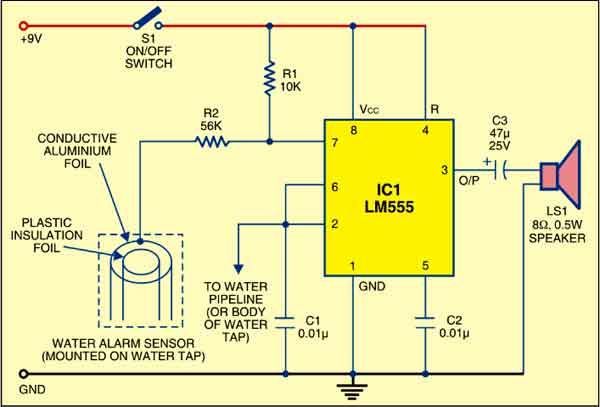 The State Jal Boards supply water for limited duration in a day. Time of water supply is decided by the management and the public does not know the same. In such a situation, this water supply alarm circuit will save the people from long wait as it will inform them as soon as the water supply starts.
The State Jal Boards supply water for limited duration in a day. Time of water supply is decided by the management and the public does not know the same. In such a situation, this water supply alarm circuit will save the people from long wait as it will inform them as soon as the water supply starts.
Water supply alarm circuit
At the heart of this circuit is a small water sensor. For fabricating this water sensor, you need two foils, an aluminium foil and a plastic foil. You can assemble the sensor by rolling aluminium and plastic foils in the shape of a concentric cylinder. Connect one end of the insulated flexible wire on the aluminium foil and the other end to resistor R2. Now mount this sensor inside the water tap such that water can flow through it uninterrupted. To complete the circuit, connect another wire from the junction of pins 2 and 6 of IC1 to the water pipeline or the water tap itself.

Circuit operation
The working of the circuit is simple. Timer 555 is wired as an astable multivibrator. The multivibrator will work only when water flows through the water tap and completes the circuit connection. It oscillates at about 1 kHz. The output of the timer at pin 3 is connected to loudspeaker LS1 via capacitor C3. As soon as water starts flowing through the tap, the speaker starts sounding, which indicates resumption of water supply. It remains ‘on’ until you switch off the circuit with switch S1 or remove the sensor from the tap. The circuit works off a 9V battery supply.
Construction & testing
Assemble the circuit on any general purpose PCB and house in a suitable cabinet. The water sensor is inserted into the water tap. Connect the lead coming out from the junction of 555 pins 2 and 6 to the body of the water tap. Use on/off switch S1 to power the circuit with the 9V PP3 battery.
The article was first published in March 2008 and has recently been updated.






